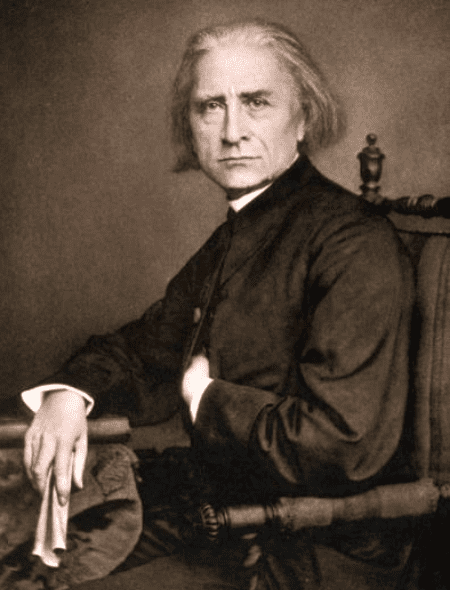LISZT: Piano Concerto No. 1
by Jeff Counts
Duration: 19 minutes in four movements (played without pause).
THE COMPOSER – FRANZ LISZT (1811-1886) – Liszt spent the 1850s in Weimar and created some of his finest works there, including the two piano concertos, Totentanz, the Faust Symphony as well as various etudes, rhapsodies and other sundry exercises. In addition to continuing his duties under the fabulous title of Kapellmeister Extraordinare, the composer had officially relocated to Weimar in 1848 (perhaps seen then an odd choice for someone of his stature) because of two important people, his employer and his second great love. With Grand Duke Carl Alexander, Liszt hoped he might co-found an intellectual “Athens of the North” and in the Princess Carolyne he saw nothing less than his future wife. Neither dream would be realized.
THE HISTORY – Both of Liszt’s piano concertos had long incubation periods. No. 1 was apparent in sketches from the early 1830s (possibly even before) and, though ostensibly “complete” by the end of that decade, it was revised repeatedly over the next two and not premiered in its final form until 1855. Liszt, ever preoccupied with structural innovation and recalling an 1836 admonishment by Robert Schumann to “invent a new form”, chose to set his concerto as a continuous flow of ideas rather than a standard three-movement work with breaks in between. Compared to the nearly contemporaneous Concerto No. 2 which, according to the previously quoted essayist Michael Steinberg is “for poet’s only”, No. 1 is a simple dazzler for any “keyboard athlete.” We should be careful, however, not to let assessments of this music’s showy nature (which are common and fair) blind us to its truly novel formal accomplishments. Other composers certainly noticed and, as with so much of what Liszt did throughout his composing life, they saw glimpses of the future in his intrepid, boisterous spirit. He well knew this about himself and cultivated it carefully. In fact, a wonderful legend about the concerto’s opening theme plays neatly into the notion of Liszt as a man fully aware, and perhaps a bit protective, of his place in the vanguard. According to the lore, Liszt and his son-in-law Hans von Bülow put secret words to the notes which (translated) say “None of you understand this, haha!” That dismissal, if true, seemed to predict and then casually wave away the opinion of critics and colleagues that Concerto No. 1 lacked the “poetry” mentioned above. It also baked in a reminder that, for all his swagger and fame, Liszt was an artist of incredible intellectual depth, and one willing to remind you of such if you forgot.

Franz Hanfstaengl, CC0, via Wikimedia Commons
THE WORLD – Elsewhere in 1855, Alexander II ascended to the Russian throne, The Daily Telegraph began publication in London, and the first bridge over the Mississippi River was constructed in Minneapolis.
THE CONNECTION – Liszt’s Piano Concerto No. 1 was most recently performed by the Utah Symphony in 2007 with Keith Lockhart on the podium and Lisa de la Salle as soloist.











